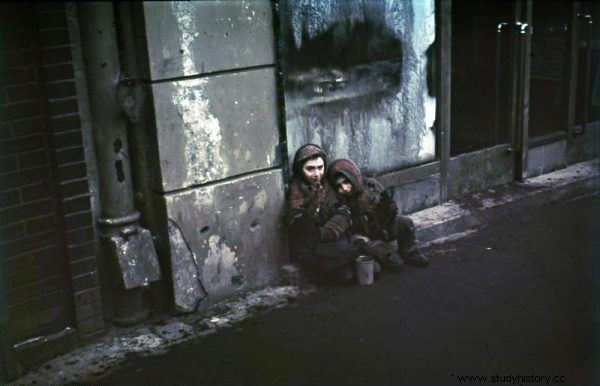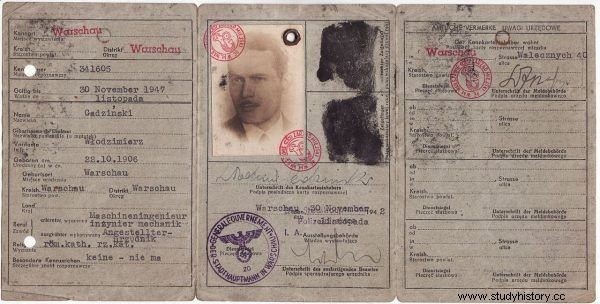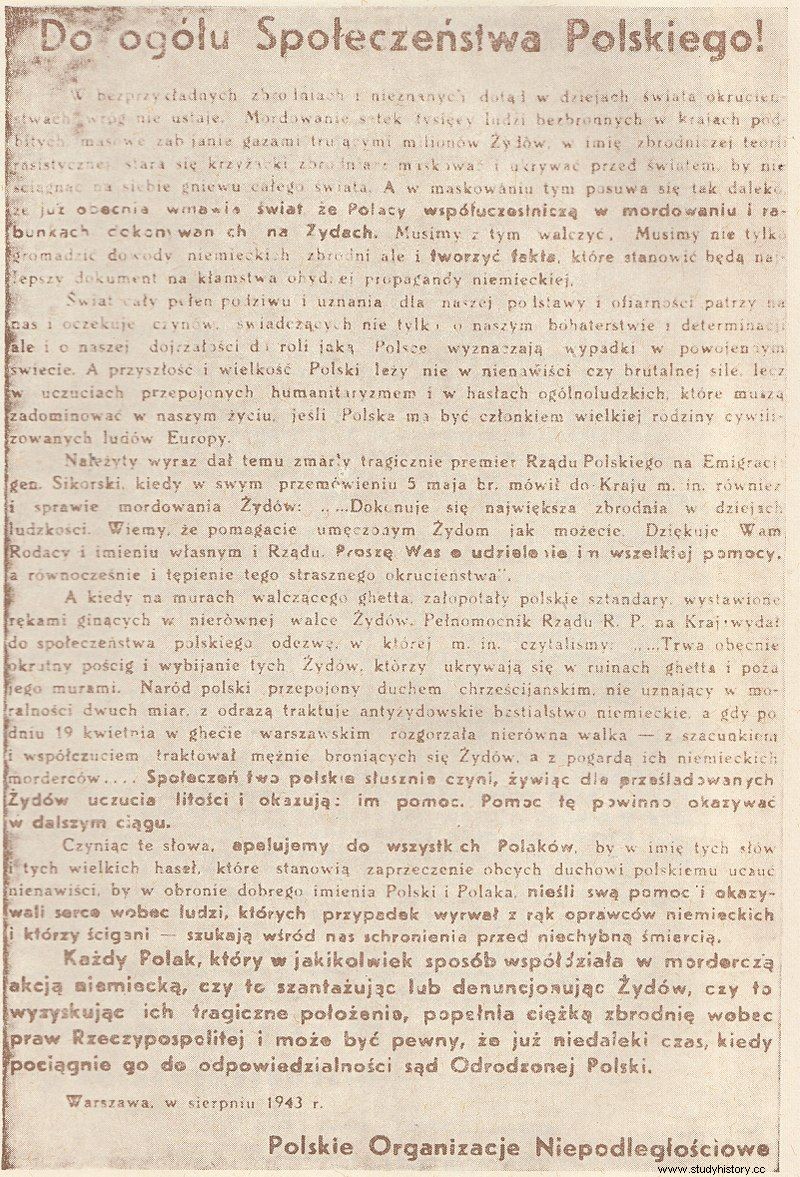It is often written that when the Germans murdered the Jews, the Poles were indifferent to the crime. In reality, however, many of our compatriots, risking their lives, tried to help the victims locked behind the wall. We remind you of their heroism.
1. Food smuggling
The provisioning situation in the ghettos was tragic from the very beginning. The Germans set food rations in such a way as to cause the greatest possible mortality of the people locked in them. The average adult card food allowance in 1940-1942 did not exceed 400 calories a day. At certain times, it was less than 200 calories. “ I was without bread three days a week, no potatoes, nothing at home. I was swollen with hunger ”- recalled Jakub Goldberg, who lived the hell of life in the Łódź ghetto.
Therefore, one of the earliest forms of help provided to Jews by Poles was to provide them with food. And so, on the very first day after the Germans closed the gates of the Warsaw ghetto (November 15, 1940), many residents of the capital brought bread for their Jewish friends and acquaintances. Later, as the Jewish quarters were increasingly isolated, various methods of smuggling food were developed.
This is how it was done, for example, by Józef Ślązak, living in Warsaw, one of the heroes of the latest book by David Serrano Blanquera, "A Girl from a Suitcase":
On Sunday, when he did not have to go to work, his mother would attach flour bags to his belt, put on a conductor's uniform, and get on a tram that passed the ghetto. At the agreed place, he threw the bags over the wall .
And this is how Jerzy Wiensko from Białystok used it:
As a child, we smuggled food into the ghetto. Several times a week, my mother used to go to villages near Bialystok to buy flour, groats, potatoes, and in May, strawberries. A hole was dug under the fence so that one half of it was on the side of the ghetto. It was masked with a sack filled with rags and lightly covered with earth. When the German walking along the fence was far and out of sight, we quickly took the bag out and squeezed the food to the other side. Money was already thrown overhead in a bundle with a stone on the other side.

Literally everything was missing in the ghetto. Help from outside came as a rescue, especially in the field of food smuggling. The photo shows the overcrowding of the closed district (1941).
It is estimated that 80 percent of the food delivered to the Warsaw ghetto was smuggled.
2. Drug delivery
In addition to food, medicines were also transported to the ghetto, which was drastically lacking there. Irena Sendler, among others, dealt with this (you can read more about it HERE). She and her friends from the Welfare Department of the Capital City of Under the pretext of sanitary inspections, Warsaw smuggled money, food, medicines and vaccines against typhus into the Warsaw ghetto. This is how Danuta, the sister of the title "Girl from a suitcase", whose story was described by David Serrano Blanquer, describes the activities of her father:
She knew her father was helping Jewish children hiding in a tram depot near the ghetto. He gave them food and medicine .
The clinics in the Kozienice ghetto were assisted by the staff of the Polish hospital. Its employees smuggled medicines, food and underwear into the ghetto many times. It was similar in Dęblin, where Polish doctors sent the necessary funds to the treatment facility in the ghetto during the typhus epidemic. The parish priest of the Church of St. All Saints in Warsaw, Fr. Marceli Godlewski, nota bene known before the war from anti-Semitic statements.
3. Throwing children over the wall
The death rate in the ghettos was frighteningly high, and it particularly affected the youngest. That is why many Jewish families decided to give their children to Poles to save their lives. Smuggling children was more complicated than shifting food. So ingenuity was what mattered. For example, Irena Sendler's group had several ways of doing this.
One was a paramedic who brought detergents and other things to the Warsaw ghetto every day to maintain at least the basics of hygiene. The children were given sleeping pills, then they were put in bags and taken out of the ghetto as victims of typhus . The second road led through the court building at ul. Leszno, which was accessible from both the city and the ghetto. Children were also led out through the basements of houses on both sides of the wall.

The non-existent "Muranów" tram depot used by Poles to transfer Jewish children to the "Aryan" side.
Another road led through the tram depot on the Jewish side. The husband of one of the liaison officers was a driver there. In the morning, he found a carton with a sleeping child in the wagon under the bench and transported it to the Aryan side. Children were also smuggled through the ghetto gate in bags and trash cans. Elżbieta Ficowska, as a six-month-old child, was transported away in a wooden box, hidden by a construction contractor on a cart in a pile of bricks. It happened that Sendler herself carried the babies in her nursing bag.
“And so, thanks to the courage of Irena Sendler and the organization for which she worked, seriously ill eight-month-old Giza Alterwajn left the ghetto. In a nursing bag (...) "- reports the rescue of the eponymous" Girl from a Suitcase "by David Serrano Blanquer.
4. Helping to escape from the ghetto
Help was also provided to adults who decided to leave the ghetto. There were, for example, escapes of people tied underneath to the carts of garbage collectors who were coming to the ghetto they also smuggled food and fugitives. Another frequently used method was to leave the ghetto in an ambulance or in a caravan taking the body of the alleged convert to a Christian cemetery. There has been a case in which Jews were transported from the Warsaw ghetto to the hospital in Kozienice in a toilet with the inscription "Achtung Typhus".
Most of the escapes required huge amounts of bribes, but there were also disinterested help. This was the case, for example, with the Polish policeman Franciszek Banas, who saved Róża Jakubowicz and her son Tadeusz during the liquidation of the Krakow ghetto. “She was walking straight to the gate where SS men were standing, she was staggering on her feet,” he recalled. Banaś bribed an SS man standing on guard and took Róża and her son out of the ghetto gate.
5. Organizing hideouts on the Aryan side
Those who managed to escape from the ghetto had to take care of a hiding place. Here, too, the help of the Poles was necessary. Support in this matter was provided by individually friendly people, and from the end of 1942, the Council to Aid Jews "Żegota". The fugitives were hidden in apartments, houses, monasteries, barns, specially prepared hiding places, hiding places and bunkers.

Apart from saving children from the Warsaw ghetto, Żegota, in cooperation with religious communities, provided Jews with Catholic baptismal certificates and helped to find hiding places on the Aryan side. The picture shows starving Jewish children.
Craftsman Staszek Jackowski in Stanisławów hid a Jewish couple behind the stove, and 30 other Jews in three bunkers equipped with beds, stoves, sewage and electricity. Leopold Socha, an employee of the Lviv city purification plant, hid a dozen or so Jews in the sewers for over a year. Weiss's seam was lost in the hiding place between the wall of the family shop and the warehouse. Relatives of the half-sister "Little Girl from a Suitcase" "survived the occupation in a specially made hiding place behind the refrigerator. They hid there for four years. ”
Many Jews who escaped from the ghetto were kept in the Warsaw zoo by director Jan Żabiński and his wife Antonina. They hid them in animal cages, in underground passages, canals, in specially dug shelters, in the back room of the lion's house and in internal rooms that could not normally be accessed. According to historian Gunnar Paulsson, author of the highly regarded book "The Hidden City", a total of 28,000 Jews were hidden on the Aryan side of Warsaw, and 70-90,000 Poles helped them.
6. Providing false documents
Each escapee from the ghetto needed half a dozen documents and changed the place of residence seven and a half times on average, so it is no wonder that in the years 1942-1943 about 50,000 false documents were produced in the underground - we read in Diane Akerman's book "Azyl", which tells about the help provided to Jews by Jan and Antonina Żabiński.
Indeed, in order to officially exist outside the ghetto, appropriate papers were needed. Only thanks to the activities of "Żegota", about 50,000 documents confirming their Christian origin were issued to Jews.

Kenkarts were identity documents obligatorily issued by the German occupation authorities to all non-German residents of the General Government who were 15 years of age or older. The Polish underground falsified them for the saved Jews.
This was done by involving the priests who issued baptism certificates. For example, one of the protagonists of the book "Little Girl from a Suitcase", who took in a Jewish child
(...) went straight to a priest from a nearby parish. “She went to ask for a false birth certificate in the name of her deceased cousin to avoid trouble with the police. I think that priest was also active in the underground.
In turn, the Polish conspiracy provided kenkarts, work cards, registration certificates and all other numerous documents required by the Germans.
7. Military Aid
The Polish underground supported Jewish military organizations that intended to put up armed resistance to the Germans. The Jewish Military Union and the Jewish Combat Organization were supplied with certain amounts of weapons, ammunition and grenades. These included 90 guns, 600 hand grenades, one erkaem, one submachine gun and 165 kg of explosives. The weapons were also donated by another underground organization - the Security Corps.
On the orders of General Grot-Rowecki, the Warsaw-based Kedyw trained members of the ŻOB in making bombs, grenades and incendiary bottles. When the uprising broke out in the Warsaw ghetto in 1943, the Home Army carried out several attempts to blow up the ghetto wall and several actions against German units located around the Jewish district. The People's Guard, the Socialist Fighting Organization and the People's Militia of the RPPS did a similar thing. There are also reports that a branch of the Security Corps took part in the fight against the Germans alongside Jewish insurgents from the ŻZW.

Leaflet from August 1943, published by "Żegota" and signed by Polish Independence Organizations, condemning blackmail and announcing penalties for people who will be proven.
8. Fighting blackmailers
Fighting blackmailers was also a form of help. The rendition of hiding Jews was considered by the Polish Underground State as a form of collaboration and punished by death. Such behavior was stigmatized in the underground press and appropriate leaflets and posters were distributed. Underground courts sentenced blackmailers, executions were supervised by Kedyw troops, and information about this was made public in the press and radio broadcasts from London.
